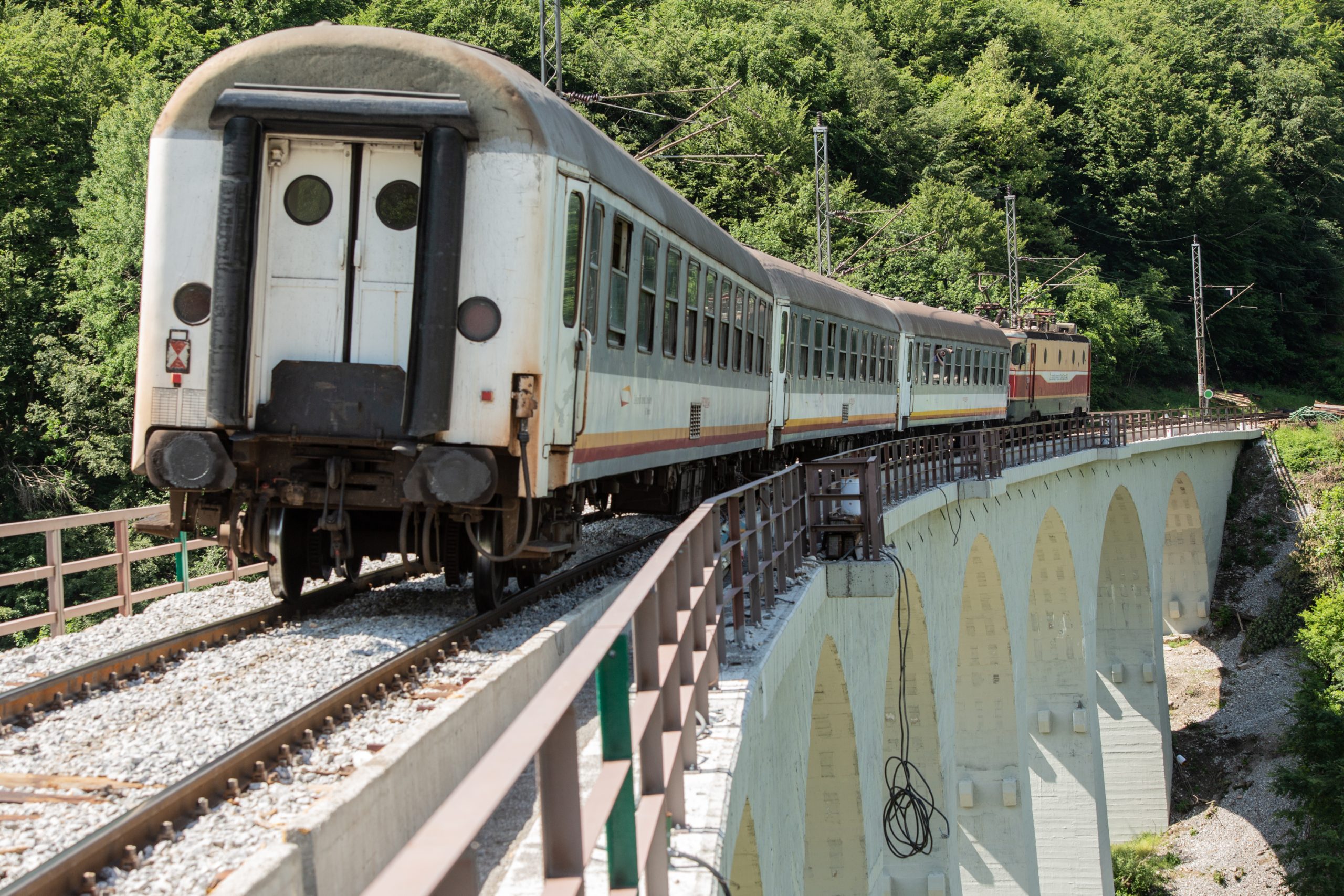
The first railway line in Montenegro was a narrow-gauge railway line from Gabela Zelenika, which opened in 1901. This railway line was built by Austria-Hungary, which governed the territory of Boka Kotorska at the time. The railway system continued to upgrade over the decades, with the major leap being made in the 1970s with the launch of the line connecting Serbia’s capital Belgrade with Montenegro’s main seaport, Bar.
When this line opened in 1976, it was a state-of-the-art railway, as modern and comfortable as any other rail network in the world. It was the largest and most expensive infrastructure project in the former Yugoslav federation and one of the most beautiful trips in Europe. The first train to make the 167-kilometre journey was the Blue Train, the luxury transport of then Yugoslav leader Josip Broz Tito, who entertained foreign dignitaries and royalty on board, including Queen Elizabeth II and the former Ethiopian emperor Haile Selassie.
“The difficult years of crisis had left a mark on the Montenegrin railways, as the railway system needs continuous monitoring and repairs. At a time of economic crisis for the country and society it was not possible to do that properly.”
Dragan Radević, deputy CEO of Capital investments, Montenegro Railways
Dragan Radević is a deputy CEO to Capital investments in Montenegro Railways and has been working for the company since 2004. However, his experience with and love for railways dates far back in time. Dragan remembers vividly his first experience of train travel, in the 1980s – the golden age of Montenegro’s railways – when he was only five years old, and his parents announced that for their summer holidays the family would be going to the seaside, by train. “I remember not sleeping all night from the excitement: not only that we were going to the seaside, but more because we would be traveling by train. A train journey was a special event at that time, and train travel still today brings a romantic and almost mystical feeling to me,” says Dragan.
However, constant underfunding left the railway with big problems by the 1990s. The Montenegrin part of the railway suffered extensively from lack of maintenance and a railway journey to Belgrade that once took seven hours started to last nearly 11 hours because the train had to slow down frequently as a result of poor tracks and infrastructure. The number of passengers dropped from a peak of almost 2 million in 1987 to 1.2 million in 2016. Freight decreased from almost 4 million tonnes to 1.4 million. “The difficult years of crisis had left a mark on the Montenegrin railways, as the railway system needs continuous monitoring and repairs. At a time of economic crisis for the country and society it was not possible to do that properly,” says Dragan.
There was a need for revitalisation, but neither the railway company nor the government of Montenegro had the financial means to support an upgrade.

“We expect to have a successful cooperation with the EU and the European Investment Bank in future projects too.”
Dragan Radević, deputy CEO of Capital investments, Montenegro Railways
In 2017 the EU stepped in. The European Investment Bank (EIB) approved a €20 million loan for rehabilitation of most critical slopes, tunnels, bridges and signal systems on the line from Bar to Vrbnica on Serbia’s border. In addition, the loan was combined with a grant worth €20 million, under the EUs Connectivity Agenda through the Western Balkans Investment Framework (WBIF). This meant that almost 90% of the total €45 million cost of the project would be covered from the EU’s budget. The project is close to finalisation and the management of the railway company expects an increase in passenger and goods transport as a result of this investment. “Therefore, we expect to have a successful cooperation with the EU and the European Investment Bank in future projects too,” says Dragan
As this project is coming to an end, Dragan explains that the Montenegrin railways is expected to embark on a new project with the support of the EU. The new project covers the rehabilitation of further tunnels & bridges, track replacement Lutovo to Bioce and refurbishment of three workshops, all on the Bar Vrbnica corridor.
About the project
The extension of the Orient/East-Med Corridor into the Western Balkans along Route 4 is approximately 580 km long and runs from Vršac (Serbia – Romania border) to Belgrade (Serbia) and then to Podgorica and Bar (Montenegro). Bar – Vrbnica (the latter at the Montenegro – Serbia border) is the most important section of the Montenegrin rail network, carrying about 20% of all passengers and about 60% of the cargo. Through the WBIF and national Instrument for Pre-Accession Assistance (IPA), the EU has allocated millions of euros for the preparation of concrete investment packages as well as urgent rehabilitation works along slopes in danger of landslides. In addition, under the Connectivity Agenda, the EU has allocated more than €20 million to cover 50% of the costs associated with the installation of modern signalling and telecommunication systems in and around Podgorica as well as the rehabilitation of 29 concrete bridges and 20 tunnels.
Photo credits:WBIF
When this line opened in 1976, it was a state-of-the-art railway, as modern and comfortable as any other rail network in the world. It was the largest and most expensive infrastructure project in the former Yugoslav federation and one of the most beautiful trips in Europe. The first train to make the 167-kilometre journey was the Blue Train, the luxury transport of then Yugoslav leader Josip Broz Tito, who entertained foreign dignitaries and royalty on board, including Queen Elizabeth II and the former Ethiopian emperor Haile Selassie.
Dragan Radević is a deputy CEO to Capital investments in Montenegro Railways and has been working for the company since 2004. However, his experience with and love for railways dates far back in time. Dragan remembers vividly his first experience of train travel, in the 1980s – the golden age of Montenegro’s railways – when he was only five years old, and his parents announced that for their summer holidays the family would be going to the seaside, by train. “I remember not sleeping all night from the excitement: not only that we were going to the seaside, but more because we would be traveling by train. A train journey was a special event at that time, and train travel still today brings a romantic and almost mystical feeling to me,” says Dragan.
However, constant underfunding left the railway with big problems by the 1990s. The Montenegrin part of the railway suffered extensively from lack of maintenance and a railway journey to Belgrade that once took seven hours started to last nearly 11 hours because the train had to slow down frequently as a result of poor tracks and infrastructure. The number of passengers dropped from a peak of almost 2 million in 1987 to 1.2 million in 2016. Freight decreased from almost 4 million tonnes to 1.4 million. “The difficult years of crisis had left a mark on the Montenegrin railways, as the railway system needs continuous monitoring and repairs. At a time of economic crisis for the country and society it was not possible to do that properly,” says Dragan.
There was a need for revitalisation, but neither the railway company nor the government of Montenegro had the financial means to support an upgrade.

In 2017 the EU stepped in. The European Investment Bank (EIB) approved a €20 million loan for rehabilitation of most critical slopes, tunnels, bridges and signal systems on the line from Bar to Vrbnica on Serbia’s border. In addition, the loan was combined with a grant worth €20 million, under the EUs Connectivity Agenda through the Western Balkans Investment Framework (WBIF). This meant that almost 90% of the total €45 million cost of the project would be covered from the EU’s budget. The project is close to finalisation and the management of the railway company expects an increase in passenger and goods transport as a result of this investment. “Therefore, we expect to have a successful cooperation with the EU and the European Investment Bank in future projects too,” says Dragan
As this project is coming to an end, Dragan explains that the Montenegrin railways is expected to embark on a new project with the support of the EU. The new project covers the rehabilitation of further tunnels & bridges, track replacement Lutovo to Bioce and refurbishment of three workshops, all on the Bar Vrbnica corridor.
About the project
The extension of the Orient/East-Med Corridor into the Western Balkans along Route 4 is approximately 580 km long and runs from Vršac (Serbia – Romania border) to Belgrade (Serbia) and then to Podgorica and Bar (Montenegro). Bar – Vrbnica (the latter at the Montenegro – Serbia border) is the most important section of the Montenegrin rail network, carrying about 20% of all passengers and about 60% of the cargo. Through the WBIF and national Instrument for Pre-Accession Assistance (IPA), the EU has allocated millions of euros for the preparation of concrete investment packages as well as urgent rehabilitation works along slopes in danger of landslides. In addition, under the Connectivity Agenda, the EU has allocated more than €20 million to cover 50% of the costs associated with the installation of modern signalling and telecommunication systems in and around Podgorica as well as the rehabilitation of 29 concrete bridges and 20 tunnels.
Photo credits:WBIF
Please wait while your video is being uploaded...
Don't close this window!